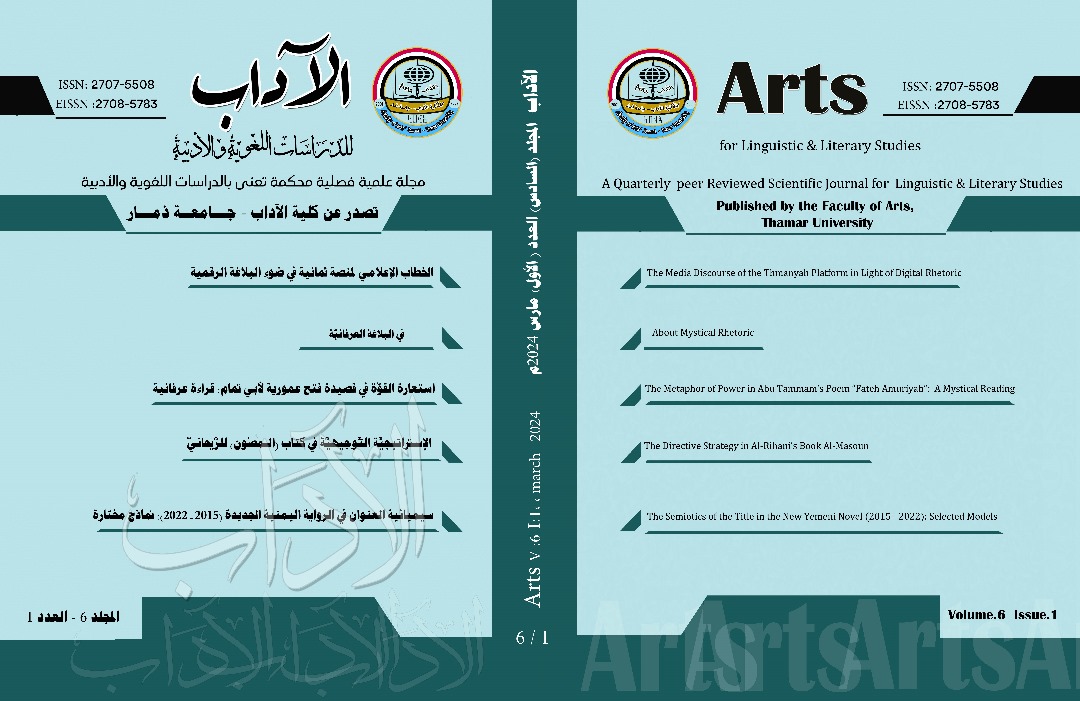The Aesthetic and Imaginative Dimensions in Receiving Poetic Sayings according to Al-Qurtajani through his Book Minhaj Al-Bulagha and Siraj Al-Udabaa
DOI:
https://doi.org/10.53286/arts.v6i1.1785Keywords:
Communication, Poetic Meaning, Interpretation, Poetic Function, ExcitementAbstract
The research aims to raise the issue of poetic creativity among ancient critics, as it is a language that indicates a functional orientation and involves multiple dimensions supported by the aesthetic and imaginative. Therefore, the discussion will be about the characteristics of aesthetic communication from the point of view of Hazem Al-Qurtajani through his Book Minhaj Al-Bulagha and Siraj Al-Udabaa. The research is divided into an introduction and two sections, the first on the recipient, while the second is on the interaction of the two poles of communication and the realization of the poetic function. The texts will be extrapolated to reach his perceptions and vision on the issue of aesthetic communication. The conclusion showed that poetic meanings are essentially associated with the imaginative element, and that the process of imagination lies in the mental activity carried out by the recipient, which is an interpretive activity in which it reconstructs images. The systematic procedure taken by Al-Qurtajani in rooting the issues of creativity and reception would reveal the depth of imaginative and critical consideration reached by the critical thinking of philosophical critics, and that it should be sensitive to the requirements of the recipient’s conditions, as the issue relates to defining the requirements of literary communication and its objectives.
Downloads
References
ابن سينا. (1973). فن الشعر ضمن كتاب فن الشعر لأرسطو (عبد الرحمن بدوي، تحقيق ط.2)، دار الثقافة.
جمعي، الأخضر. (1996). نظريّة الشّعر عند الفلاسفة الإسلاميين: خلاصة قراءة، مجلة اللغة والادب، 5(1)، 5-12.
الشايب، أحمد. (2003). الأسلوب دراسة تحليلية لأصول أساليب الخطاب (ط.12)، مكتبة النهضة المصرية.
صمود، حمادي. (1988). الوجه والقفا في تلازم التراث والحداثة (ط.1). الدار التونسية للنشر.
صمود، حمادي. (2010). التفكير البلاغي عند العرب: أسسه وتطوره إلى القرن السادس ( مشروع قراءة) (ط.3). دار الكتاب الجديدة المتحدة.
عبد المطلب، محمد. (1995). جداية الإفراد والتركيب في النقد العربي القديم (ط.1). الشركة المصرية العامة للنشر لونجمان.
عبد المطلب، محمد. (1995) قضايا الحداثة عند عبد القاهر الجرجاني (ط.1). مكتبة لبنان ناشرون، والشركة المصرية العالمية للنّشر- لونجمان.
عصفور، جابر. (1978). مفهوم الشّعر: دراسة في التراث النقدي، دار الثقافة.
القرطاجني، حازم. (1981). منهاج البلغاء وسراج الأدباء (محمد الحبيب بن الخوجة، تحقيق ط.2)، دار الغرب الإسلامي.
المرعي، فؤاد. (1994). في العلاقة بين المبدع والنص والمتلقي، عالم الفكر، 23، (1، 2)، 335-360.
اليوسفي، مصطفى لطفي. (1992). الشّعر والشعرية، الفلاسفة والمفكرون العرب ما أنجزوه وما هفوا إليه، الدار العربية للكتاب.
Reference
Ibn Sīnā. (1973). Fann al-Shiʻr ḍimna Kitāb Fann al-Shiʻr li-Arisṭū (ʻAbd al-Raḥmān Badawī, taḥqīq 2st ed), Dār al-Thaqāfah, (in Arabic).
Jamʻī, al-Akhḍar. (1996). Naẓarīyat al-Shiʻr ʻinda al-Falāsifah al-Islāmīyīn: Khulāṣat Qirāʼah, Majallat al-Lughah & al-ʾAdab, 5 (1), 5-12, (in Arabic).
al-Shāyib, Aḥmad. (2003). al-Uslūb Dirāsah Taḥlīlīyah li-Uṣūl Asālīb al-Khiṭāb (12 Ed), Maktabat al-Nahḍah al-Miṣrīyah, (in Arabic).
Ṣammūd, Ḥammādī. (1988). al-Wajh & al-Qafā fī Talāzum al-Turāth & al-Ḥadāthah (1st ed). al-Dār al-Tūnisīyah lil-Nashr, (in Arabic).
Ṣammūd, Ḥammādī. (2010). al-Tafkīr al-Balāghī ʻinda al-ʻArab: ususuhu & taṭawuruh ilá al-qarn al-Sādis (Mashrūʻ Qirāʼah) (3rd ed). Dār al-Kitāb al-Jadīdah al-Muttaḥidah, (in Arabic).
ʻAbd al-Muṭṭalib, Muḥammad. (1995). Jidāyat al-ʼIfrād & al-Tarkīb fī al-Naqd al-ʻArabī al-Qadīm (1st ed). al-Sharikah al-Miṣrīyah al-ʻĀmmah lil-Nashr Lūnjmān, (in Arabic).
ʻAbd al-Muṭṭalib, Muḥammad. (1995) Qaḍāyā al-Ḥadāthah ʻinda ʻAbd al-Qāhir al-Jurjānī (1st ed). Maktabat Lubnān Nāshirūn, & al-Sharika al-Miṣrīyah al-ʻĀlamīyah lil-Nashr-Lūnjmān, (in Arabic).
ʻUṣfūr, Jābir. (1978). Mafhūm al-Shiʻr: dirāsah fī al-Turāth al-Naqdī, Dār al-Thaqāfah, (in Arabic).
al-Qarṭājannī, Ḥāzim. (1981). Minhāj al-Bulaghāʼ & Sirāj al-Udabāʼ (Muḥammad al-Ḥabīb ibn al-Khūjah, taḥqīq 2st ed), Dār al-Gharb al-Islāmī, (in Arabic).
al-Marʻī, Fūʾād. (1994). fī al-ʻAlāqah bayna al-Mubdiʻ & al-Naṣṣ & al-Mutalaqqī, ʻĀlam al-Fikr, 23, (1, 2), 335-360, (in Arabic).
al-Yūsufī, Muṣṭafá Luṭfī. (1992). al-Shiʻr & al-Shiʻrīyah, al-Falāsifah & al-Mufakkirūn al-ʻArab mā Anjazwh & mā Hafwā ilayhi, al-Dār al-ʻArabīyah lil-Kitāb, (in Arabic).
Downloads
Published
How to Cite
Issue
Section
License

This work is licensed under a Creative Commons Attribution 4.0 International License.
Copyright and Licensing
copyright is retained by the authors. Articles are licensed under an open access Creative Commons CC BY 4.0 license, meaning that anyone may download and read the paper for free. In addition, the article may be reused and quoted provided that the original published version is cited. These conditions allow for maximum use and exposure of the work.


























